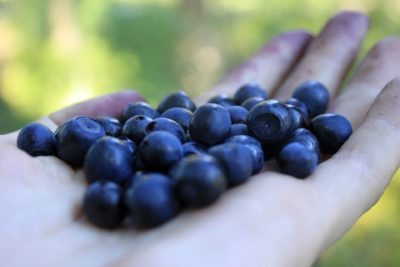
Bilberry
Bilberries are found in Europe, northern Asia, Greenland, and the Western parts of Canada and United States.
Bilberry fruits are used to make jams or in pies, sometimes in combination with other forest fruits.
For nearly 1000 year, bilberry fruits have been used as a medicine for circulatory problems, diarrhea and other problems. Also leaves of bilberry have medicinal properties and are used for diabetes and other problems.
Names
Scientific
Vaccinium myrtillus
English
Bilberry
Black-hearts
Blaeberry
Blue Whortleberry
Common bilberry
European blueberry
Fraughan
Myrtle blueberry
Whinberry
Whortleberry
Wimberry
Winberry
Windberry
Dutch
Blauwe bosbes
Spanish
Arándano
Mirtilo
French
Myrtille
German
Bickbeere
Blaubeere
Heidelbeere
Moosbeere
Schwarzbeere
Waldbeere
Wildbeere
Zeckbeere
Italian
Mirtillo nero
Taxonomy
Order
Ericales
Family
Ericaceae
Genus
Vaccinium
Species
Vaccinium myrtillus (Bilberry)
Basic information and facts
Origin:
Distribution:
Bilberries grow in temperate regions in Europe, northern Asia, Greenland, and the Western parts of Canada and United States.
Evergreen or deciduous:
Deciduous
Flowers:
Leaves:
Fruits:
Climate and weather:
Bilberries grow in temperate and subarctic climates.
Pollination:
Height:
Bilberries are 15 to 60 cm tall.
Type of soil:
Bilberries grow well in very acidic, nutrient-poor soils.
Spacing
Propagation:
Insect pests:
Diseases:
Harvesting:
Bilberries are harvested by hand picking when the fruits are ripe.
Uses:
Bilberries can be eaten fresh (right of the bush while walking in the forest) or they are used to make jams or as filling in pies and cakes, often in combination with other “forest” fruits.Fruits and leaves are used for their medicinal properties.
Proverbs and Quotes
Who knows a proverb or quote about Bilberry?
Recipes
No recipe yet.
Crop categories
Cool temperate crops
Fruits
High altitude crops
Medicinal plants
Temperate crops
Wild-harvested crops
Pictures

Bilberries

Bilberry
